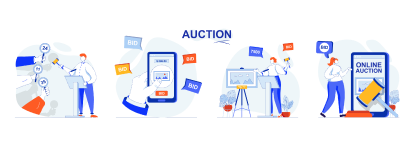Before diving into custom eCommerce development and investing in the designated product, the project's team structure is worth considering. So, what does the typical flow of actions look like? First, you must assemble qualified people for the job and start the project!
Sounds easy, but project leaders must go beyond finding the best developers or designers. When forming the best eCommerce team structure, it is necessary to ensure the team’s work aligns with business goals and that they are ready to tackle the challenges of rapid growth.
How do you ensure a team's success and prove that you did everything right when composing a team structure for an eCommerce business? In this article, we’ll share insights on picking the right members to join the team and disclose how to make the most of it for the project.
At Geomotiv, we can create a team that will include skilled specialists with niche expertise in full accordance with your needs!
eCommerce Team Structure
Which positions to fill to build an eCommerce team from scratch? You will probably need specialists to cover all stages of the project’s life cycle. They can handle all types of tasks: from requirements gathering to release, maintenance, and growth.
Team size and composition may vary depending on the type of the project, its budget, and other factors. However, in any case, the project’s success demands the right specialists with the right expertise. So, without further ado, let’s list the most important ones.

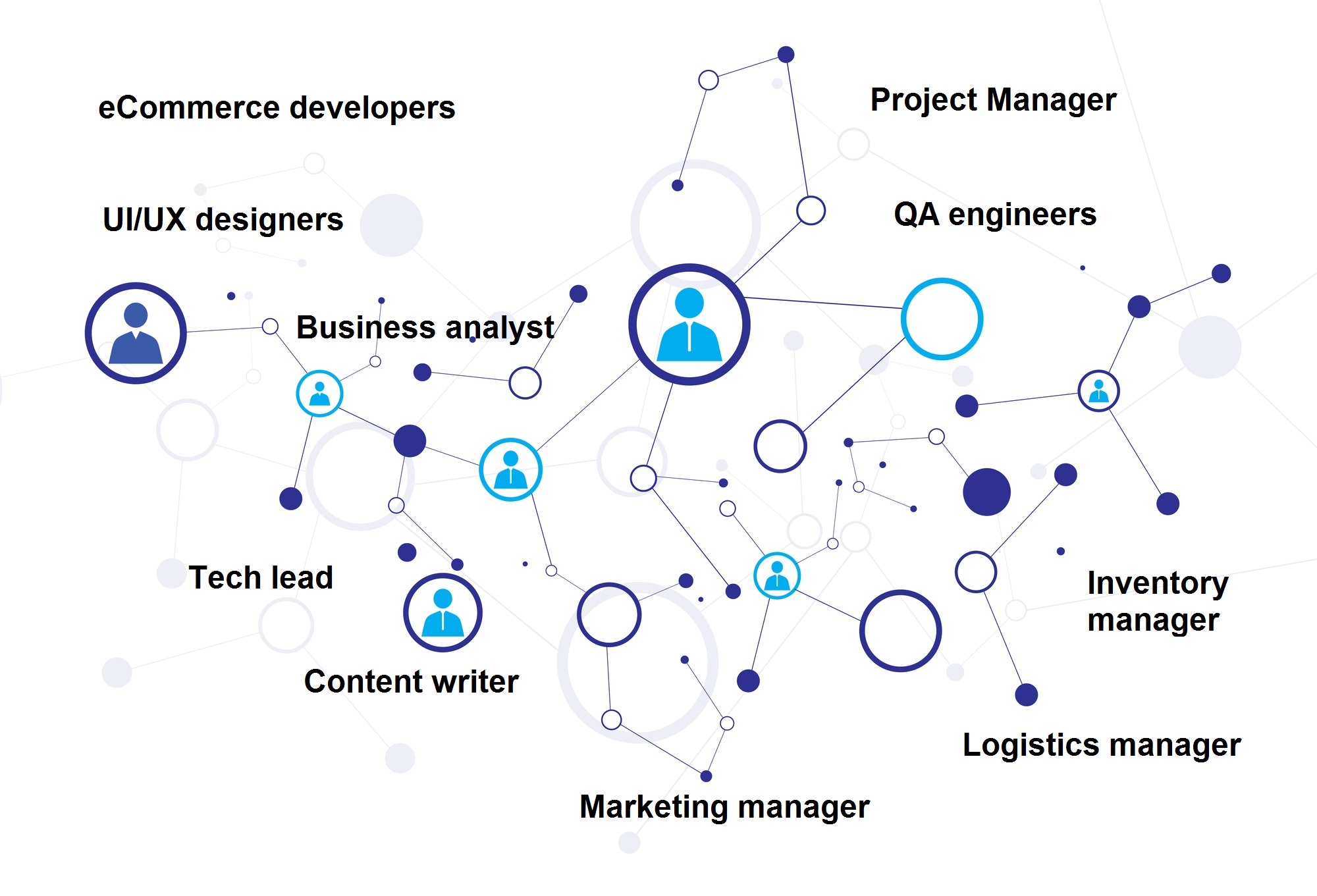
- ECOMMERCE DEVELOPERS
A core element of a well-planned e-Commerce team structure is individuals handling technical development and project implementation. Experts in this role deeply understand eCommerce technologies, integration tools, and development methodologies. In addition, they can bring their previous industry expertise and skills to ensure seamless operations of future solutions.
When will it be reasonable to work with eCommerce developers?- You plan to create a custom solution from scratch. A team of eCommerce experts can handle tasks of any complexity from start to finish. You may hire front-end and back-end developers or opt for a full-stack specialist who blends the two roles.
- You want to enhance your solution. For example, you may need to add new features to an existing eCommerce solution, redesign it, optimize the codebase, or migrate it to a unique platform.
- You are building an eCommerce business on top of an intuitive SaaS solution. In this case, an IT specialist will remain a core team member. Experts of that kind will ensure customer data security, continuously enhance the product catalog, and integrate third-party services to meet changing demands.
Whatever the scenario, companies can hire an eCommerce developer in-house, engage with a dedicated development team, or source the correct type of tech talent directly from an eCommerce development company like Geomotiv. We’ll examine the dissimilarities between these three hiring alternatives later in the article.
- UI/UX DESIGNER
One of the most in-demand positions within the team structure for eCommerce business is that of a UI/UX designer. Their role involves creating a user experience that meets customer expectations. Another aspect is ensuring that the layout and graphic design are consistent with the brand image.
Like in any industry, UI/UX designers help create a good user experience that improves engagement, retention, and conversion rates. To reach the desired objectives, designers bring to the table a combination of soft and complex technical skills:- the ability to conduct user research and interpret findings to understand what issues users face when interacting with an online store;
- wireframing and prototyping proficiency;
- understanding business goals and finding optimal ways to meet those goals while still focusing on end-users;
- delivering consistent UX across all channels of customer experience;
- collaborating with other team members to meet ongoing stakeholders’ expectations;
- proficiency with A/B testing and following the latest industry and consumer trends to develop superior solutions.
- BUSINESS ANALYST
A business analyst (BA) plays an essential role in any company, and eCommerce businesses are no exception. A BA bridges technical and business stakeholders responsible for project development and implementation. Such a specialist works with a project manager and other stakeholders at the initial stages of project implementation. A BA helps shape the project vision, elicit requirements, and define product features.
A top-notch eCommerce business analyst will know how to prepare business requirements for technical teams and eliminate any disruption in communication between the technical lead and project manager. Besides, a business analyst caters to various activities, such as the company's goals and KPIs, researching competitors, and analyzing growth opportunities. - PROJECT MANAGER
The primary goals of a project manager are to coordinate the work of the development team, plan the activities, and ensure the team is aligned with stakeholders’ expectations. This position requires strong project management skills, excellent communication and collaboration skills, and the ability to resolve conflicts and initiate solutions.
Project managers are responsible for meeting the requirements, fitting the scope and budget, and keeping up with the deadlines. Project managers are also in charge of communication with stakeholders regarding the project’s progress. If you want to learn more about this role, we recommend you read this article on our blog. - QA ENGINEERS
As a QA, a specialist becomes a vital member of the eCommerce product team structure. A QA professional ensures the quality of each deliverable within the estimated timeline and assists in detecting any issues that might affect the performance and user experience.
The amount and the hierarchy of QA activities may vary from project to project, depending heavily on the scope of the work and the project’s objectives. However, as a rule, a QA specialist is involved in the process of creating eCommerce software as early as possible. - TECH LEAD
The role of a tech lead in eCommerce projects is to overlook the output produced by the development team, conduct code reviews, and prioritize and delegate tasks. Besides, such a specialist serves as a technical point of contact between the development team and non-technical specialists. Tech leads see the big picture of the technical risks and can predict future roadblocks for the project. A tech lead also mentors individual team members, helping them handle technical challenges rather than personally accomplishing the most difficult tasks. - CONTENT WRITER
These specialists create a clear and engaging copy of the eCom website, including product descriptions, promotional materials, blog posts, and other essential pieces of content. The primary goal of any generated content is to convert website visitors into paying customers. Besides, quality content optimized for SEO will help your brand rank higher on search engines and outperform direct competitors. - MARKETING MANAGER
Digital promotion is a vital aspect of eCommerce operations. It helps spread the word about your brand and improves conversions in the existing customer base. The job of a marketing manager is to leverage the most appropriate marketing tactics and create a strategy to succeed with campaigns.
Marketing managers also collaborate with eCommerce developers to implement these strategies efficiently. For example, a competitor or customer analysis suggests that new discount or rewards programs must be reflected on the eCommerce website. Then, the marketing manager ensures that all features align with customer expectations and contribute to the best UX. - INVENTORY MANAGER
Even when we talk about a small eCommerce team structure, it is hard for one person to wear more than one hat. For example, imagine you have to send the goods when the holiday season peaks and many clients rush to your online store. What happens if you run out of stock but overlook that?
Solid inventory management is the backbone of a successful eCommerce business. And a skilled inventory manager is dedicated to registering and overlooking the materials and products and settling any inventory-related questions. This role is vital for eCommerce teams since it helps to ensure that everything works as intended. - LOGISTICS MANAGER
Online shopping involves selling and buying actual products that must be transported to warehouses and delivered to paying customers. The primary responsibility of the logistics manager is to ensure a safe flow of products from manufacturers to customers and a timely and frictionless shipment to end-consumers.
Steps to Building an Efficient eCommerce Team Structure

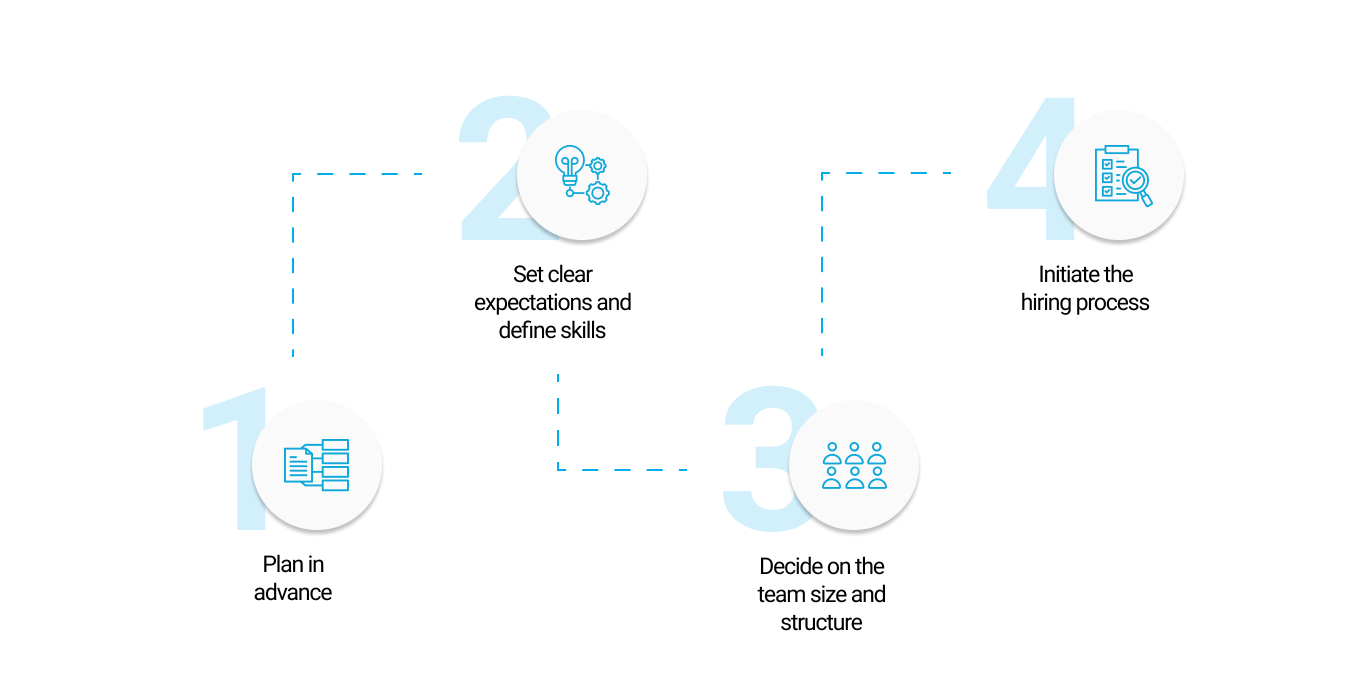
- Plan in advance.
One of the first steps toward creating the best eCommerce team structure is to outline a detailed list of project needs and goals and develop a strategy. Initial analysis and planning activities will help identify which roles you need to fill from the get-go and which ones can be added during the project.
For example, if you need to add new features to an existing website, you may need to hire web developers and designers in the first place. On the other hand, if the most vital goal is to generate more sales, then the hiring decisions will shift in the direction of marketing and sales specialists.
At this stage, ensuring everyone is on the same page regarding the overall hiring strategy is essential. In addition, you must communicate each important strategic decision internally to build a sense of ownership and accountability. - Set clear expectations and define skills.
Using the results of the initial planning, it is easier to assign responsibilities to a potential eCommerce team. With clearly outlined expectations, you can pose specific requirements for potential candidates and define the best combination of skills and expertise necessary for the project’s success.
There should be a clear and concise picture of what you want to achieve using the cross-functional resources you will hire. Otherwise, moving forward with each consecutive project development step would be hard when you don’t have complementary skill sets. You can’t expect one specialist to carry the weight of the entire project, so you need to balance this aspect and think over it thoroughly. - Decide on the team size and structure.
Decide on the size of your eCommerce team and create the proper hierarchy of roles. Not only will it set a direction for the hiring team, but it will help outline other aspects of the development process, such as:- the development time;
- hiring costs;
- per-specialist salary;
- the number of resources needed for team management and training, etc.
- Initiate the hiring process.
It is time for the HR department to start searching and screening potential candidates. You can add other specialists to the process. For example, a technical specialist can help compose a test task and check its results.
However, finding the right resources to fill the IT eCommerce team structure is more than just a matter of technical skills. It is equally important to look for soft skills and find candidates compatible with the company’s culture and corporate values.
All this can be done internally by your in-house HR specialists. But if you want to save your time and inner resources, you can establish cooperation with an IT staff augmentation partner like Geomotiv. In this case, you must share your requirements and expectations, and your partner will find the best candidates.

Read the article explaining the ins and outs of hiring tech specialists to develop eCommerce websites on Magento, WooCommerce, and PrestaShop.
Focus on ongoing team retention is crucial
One of the key priorities when creating an efficient team structure is to ensure the actual workspace is comfortable and motivating from the get-go. While your eCommerce team is responsible for utilizing their soft and hard skills to reach a common goal, you’re accountable for creating a work environment that fosters long-term commitments.
Many eCommerce projects require specialized roles such as Magento developers, experienced tech leads, QA engineers, etc. Yet, unfortunately, many companies need to do more to retain and reward members of the best talent.
Here’s what you can do to improve team retention and incentivize specialists.
How to retain specialists for an eCommerce project?

- Develop an efficient onboarding process.
The onboarding process begins when a new hire accepts the job offer. It encompasses the activities to make new employees feel valued, understand their role and overall hierarchy, and boost their productivity and performance from the onset.
Here’s what companies can do to succeed with the onboarding process:- schedule regular one-on-one meetings with new employees;
- conduct monthly/quarterly/yearly check-ins with new hires to gain feedback;
- organize informal discussions with new team members and specialists who will work closely with them;
- assign a peer mentor to support and guide a new employee;
- customize the onboarding process to specific roles.
- Offer career advancement opportunities.
Individual career growth opportunity is a motivating factor for any high-profile specialist in any role. It makes employees feel valued and recognized, which, in turn, affects their commitment and adherence to your company.
Career growth goes hand in hand with an increased number of responsibilities. Make sure that you acknowledge the fact and take proactive steps to improve the productivity of each specialist. For example, you can develop incentives that promote well-being, such as granting extra days off or allowing flexible work hours. - Create a healthy work environment.
A healthy work environment means employees feel valued and acknowledged for their contributions. Therefore, it is crucial to employee retention as it improves team morale, productivity, and creativity. Besides, it promotes teamwork while providing employees the flexibility and freedom to reach their pursuits.
Which steps do we take to make the workspace healthy for employees? Let’s list some of the actionable tips below:- make the communication open and transparent;
- recognize individual success stories and share them with all team members;
- support collaboration rather than competition in a group;
- avoid micromanagement and learn to trust employees;
- invest in regular team-building activities;
- create a strong culture of feedback.
- Prioritize flexibility.
How to structure an eCommerce team and ensure that people will stick to your company? First, it’d be good to explore their personalities and adjust the management process to the needs of each individual.
Say you operate a team of senior eCommerce developers. For instance, you can give them more freedom and flexibility in their workday instead of monitoring their progress with the tasks every day. On the other hand, when you hire new specialists that haven’t worked independently, it is better to provide them with day-to-day support.
Another idea is to provide remote work opportunities and flexible hours for employees that perform well in these formats. With the rise of automated reporting and management tools, more and more companies have shifted to a hybrid work format. It allows some of the employees to work from the comfort of their homes and collaborate with in-office specialists without disruption.
Challenges of Building an eCommerce Team
As we mentioned above, eCommerce teams comprise different roles and positions covering many areas. From designing and developing a fully-functional website to other areas like marketing and logistics, eCommerce professionals must show specific expertise to contribute to overall success.
As the competition in the eCommerce industry remains tight, company leaders have to face multiple challenges to get the ball rolling. Here’s what to be aware of when assembling an eCommerce team for the project.
- Lack of agility.
eCommerce businesses need to anticipate seasonal changes, react to exploding customer expectations, and introduce changes dictated by the market and competitors. Failure to provide an excellent shopping experience and customer service may result in lost sales and missed opportunities for business growth.
Lack of speed and agility is one of the top issues eCommerce businesses face. It hinders overall productivity and slows the pace of innovations and digital transformation. As a result, many companies need help adjusting their strategies to meet and exceed what consumers expect.
To be agile, eCommerce companies need to create a team structure that can introduce quick changes in website design, content, loyalty programs, and UX elements. Make sure to hire individuals who know how to establish personalized connections with customers, can adapt to change, and extend their efforts when the need arises.
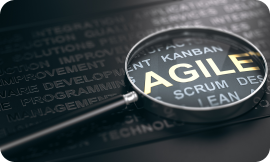
We’ve prepared a comprehensive article that covers all the significant characteristics and benefits of this approach.
- Skills shortage and talent loss.
Did you know that 55% of decision-makers need help to hire the right specialists at the right price? According to research conducted by Mercer, one of the top hiring concerns is the timely provision of qualified employees for project needs.

eCommerce projects require human resources with the right skills and experience. eCommerce businesses invest heavily in creating the most pleasant customer experience. Unfortunately, this often leads to employees having to put up with lousy work experiences or switching jobs because of a hostile workplace environment. Therefore, creating a company culture prioritizes a positive work experience and is essential to avoid failure.
To retain your staff, it is essential to ensure favorable working conditions for everyone. Our tips on creating an agile workplace environment will help you elaborate on the best approach.
- Compliance issues.
eCommerce companies store and process sensitive information about existing customers and new website visitors. This data helps identify the right strategies to:
- generate leads,
- create personalized campaigns,
- improve cart abandonment rates,
- avoid micromanagement and learn to trust employees;
- other day-to-day activities.
But it is necessary to ensure that this information is collected without violating privacy rights. Otherwise, legal issues, including emerging ones, can burden the company’s reputation. For example, based on the type of products or services a company sells and the customers' location, the online selling activity may fall under one of the regulations, local laws, or other limitations.
Similarly, a breach in security systems may lead to losing your customers’ data. That could result in viability losses, damaged reputation, and other critical risks. As a company responsible for keeping eCommerce customer data safe and secure, your business must work hard to prevent compliance and data security issues.
- Changing customer expectations.
Keeping an eye on what’s trending in the industry is a must-have for eCommerce businesses. Another aspect is to be able to respond quickly to shifting expectations. And when it comes to forming an eCommerce team, being aware of ever-evolving consumer demands becomes a ground rule.
You can assemble a team of professionals and get started with an eCommerce project, but you will also have to ensure that they can scale up and down their efforts to meet customer expectations. As challenging as it may sound, building great customer experience goes hand in hand with tight competition from large eCommerce brands like Amazon.
What can companies do to ensure a memorable experience in their online store?
- It is necessary to fill the eCommerce team with proactive individuals who can think outside the box and deliver personalized service at scale.
- It is essential to create a team structure that can move in the right direction based on what customers tell them.
- Technology challenges.
When starting an eCommerce project, hiring and technical decisions go hand in hand. Especially when creating an eCommerce solution from scratch, wrong technology or platform choices can impair the development process and put at risk later stages of software delivery.
Performance issues, lack of features that help differentiate from the competition, and failure to meet business goals are just a few risks we can mention. Additionally, it is necessary to consider compatibility issues and the technology’s ability to support business growth.
Companies must do a lot of preliminary research to choose fitting technologies and platforms for their project. However, it is necessary to remember that current business goals also leave room for growth plans.

Share your project goals and vision, and let us help you make the best technology choices based on your use case.
In-house vs. Outsourced Teams: Pros and Cons
A reliable eCommerce team contributes to the success of a project. When you need to cover hiring needs, there are several options. You can assemble a full-service in-house team or outsource some activities. How to choose the right choice and make a proper decision?
Let’s consider the two options and their strong and weak sides for eCommerce projects.
In-house eCommerce teams
If you hire eCommerce experts in-house, you can bring the right combination of skills and knowledge aboard without outside help. In this case, the company can rely on on-site specialists that will work in one location and be fully managed and controlled.
In-house eCommerce teams are responsible for creating custom software products that accurately reflect the company’s needs. And when a business needs change, the team can immediately introduce and implement new features.
What are the biggest pros of in-house approach to hiring?
- Complete control of all activities. An in-house team consists of local hires within direct reach in one location. This helps to have complete control over the processes, reporting routines, and deliverables. In addition, when there is a need for urgent adjustments, the team will be available for a meeting immediately and in person.
- Direct communication. In-house employees are in one location, although they may work from home or share the same office. Anyway, there is always room for one-on-one communication, which boosts productivity and engagement. This factor contributes to faster resolution of issues, better collaboration across departments, and more efficient team management.
- Shared values. Teams operating in a shared environment are better aligned with the company’s values and culture. In-house employees don’t need additional explanations regarding the organizational structure, reporting hierarchy, and other administrative procedures. Unlike outside resources, they are better aware of their company's long-term goals and needs.
What are the biggest cons of in-house hiring?
- Scarcity of local talent. Companies can find it difficult to source local talent for eCommerce projects. Talent shortage, tight competition for the best minds, and other hiring challenges can increase time-to-fill. As most specialists can already be employed, HR managers need to offer incentives to potential hires and go up and beyond to attract talent from other companies.
- High overhead costs. Hiring in-house can get expensive in the long run. Employers must pay salaries and cover overhead costs to set up and maintain workspaces. Besides, other lines of expenses include employee benefits, medical insurance, team-building activities, and so on.
- High investment in retention. To keep employees loyal to the company, HR specialists need to appreciate their contributions to the company. Therefore, it is an ongoing process encompassing all stages of talent acquisition: from hiring and onboarding to training and professional development.
In-house hiring offers unprecedented convenience in terms of project management and control over its progress. However, the above disadvantages can make decision-makers turn their heads to other alternatives, such as hiring remotely from popular outsourcing destinations. So let’s look at the essence of this approach and outline its primary pros and cons.
Outsourced eCommerce teams
In this case, a company can search and hire candidates from different parts of the world and delegate project tasks to qualified individuals or teams.
Moreover, working with a company that provides project-based outsourcing services is an option. In this case, you will provide your project requirements, and your IT partner will be responsible for all the stages of the project realization, from team assembly to software development and deployment.
Outsourcing enables companies to fill almost any position in any eCommerce team structure diagram. It helps remove geographical boundaries and find experienced specialists in web development, data analytics, and other in-demand roles.

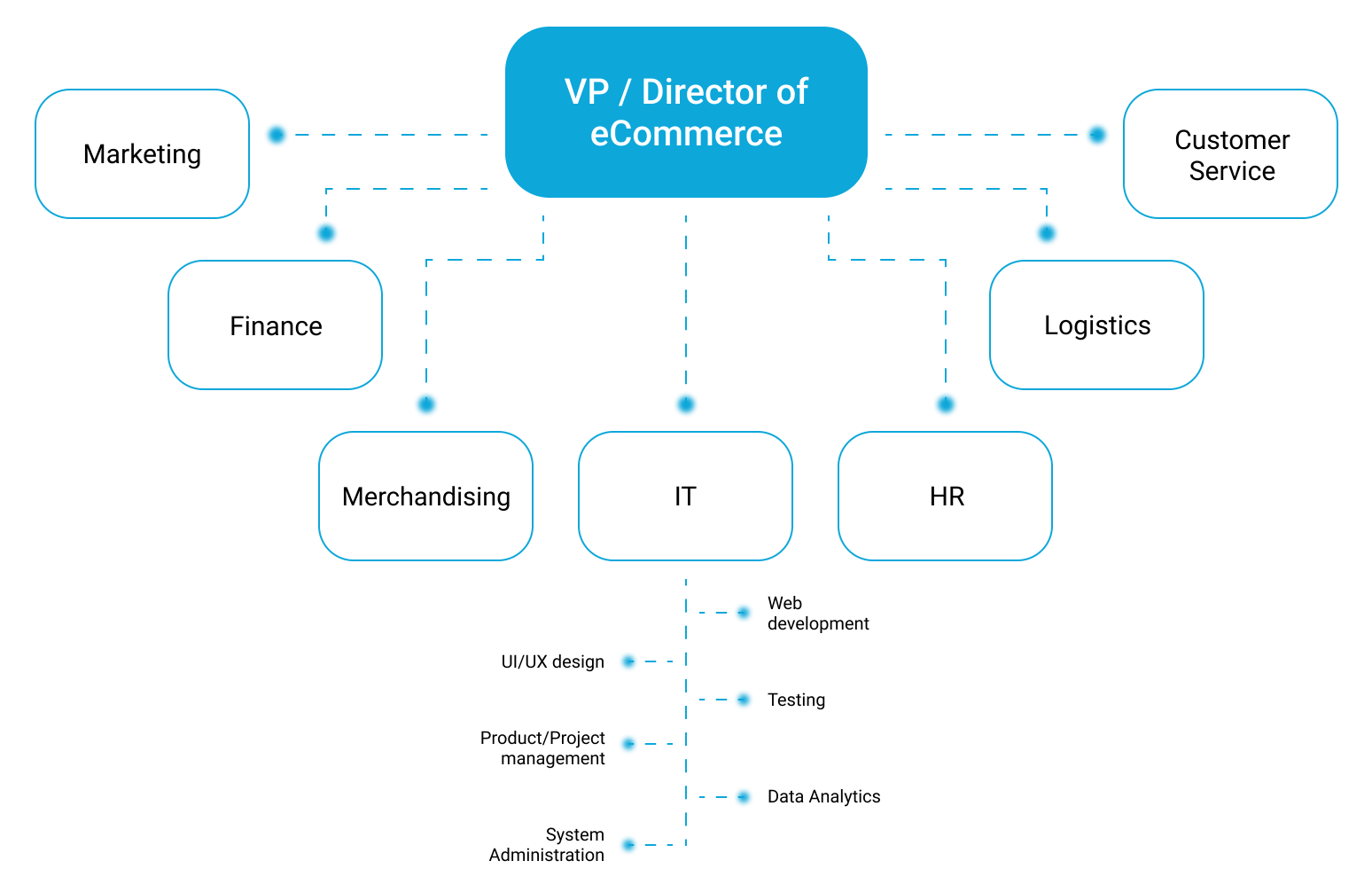
However, it is not advisable to outsource critical tasks that differentiate your business from the crowd. The most significant company values are executive positions, C-level management staff, and specialists possessing core competencies. Keep in mind that keeping the most vital areas in-house is crucial.
Say you need a marketing team that can promote your business and drive its expansion. Such a team must be aware of the company’s values and the building blocks of a brand image. Those responsible for creating a growth strategy need to handle their duties in-house.
External contractors may have the right skills and experience to fill the roles. What if they don’t align with your vision? Then, you may risk the business's success, move in the wrong direction, and end up rebuilding the entire project from scratch.
While the core teams usually operate in-house, outsourcing eCommerce software development can become a good idea. Let’s explain why.
What are the biggest pros of hiring outsourced eCommerce teams?
- Cost-efficiency. Access to specialists from around the world enables companies to take advantage of lower developer rates for the same level of expertise. Besides, it is possible to save on administrative and overhead costs associated with in-house hiring.
- Enhanced productivity. Delegating complementary activities to external specialists can remove pressure from on-site employees. Outsourcing non-core tasks help to focus on the most essential parts of the work without distractions and improves productivity.
- Faster time-to-market. Outsourcing enables businesses to reduce time-to-fill for long- and short-term positions. Thanks to faster and more efficient talent acquisition, eCommerce projects can be implemented more quickly and enter the market ahead of the pack.
What are the biggest cons of outsourced hiring?
- Possible communication gaps. Long-distance cooperation with outsourcing providers can involve time zone gaps, language barriers, and cultural differences. Communication delays can become an issue if an outsourced team doesn’t rely on an efficient infrastructure to compensate for the distance.
Geomotiv’s answer to this challenge: our developers, for instance, are used to working in different time zones and adjusting their schedules to the client’s needs. They are also comfortable cooperating with people from different cultures and backgrounds.
Our team uses an advanced infrastructure to facilitate ongoing communications with clients’ in-house teams. We rely on video conferencing, messaging, file sharing, and project management tools to establish timely reporting and discussion routines. - Limited control. The risks of delays and project failure can put off companies willing to engage remote specialists from outsourcing providers. That’s why your hiring partner should ensure they’d be able to meet deadlines and provide quality deliverables with minimal supervision.
Geomotiv’s answer to this challenge: our clients can have peace of mind with our remote eCommerce developers. There is no need to micromanage our team’s work since our specialists are self-sufficient and maintain the highest code standards. With us, you can be sure we are doing our best to meet the most stringent deadlines. - Disengagement. Some employers can assume that geographically distant team members can perform poorly or do just the bare minimum, leading to project failure. Any cooperation with outsourced teams requires a high level of trust. It is a good idea to check the credibility of a chosen outsourcing vendor before starting the collaboration with them.
Geomotiv’s answer to this challenge: we know how to set up and operate remote eCommerce teams and establish an efficient and motivating microclimate. Our HR specialists put much effort into empowering each team member with the right tools to succeed. Besides, we take care of team-building activities, provide career growth opportunities, and focus on team retention by default.
Final Word
This post looked at the best ways to structure a team for eCommerce projects. An adequately built group of professionals can become one of the most valuable assets for any company. As eCommerce businesses face fierce competition and changing customer expectations, they need to rely on results-driven teams that can lead to success.
However, selecting the right specialists and building a solid team can be challenging. The good news is that you can follow the best practices for hiring and retaining eCommerce teams.
Undoubtedly, an ideal structure will vary depending on the specific project’s needs. However, in most cases, you will need experienced developers, UI/UX designers, a business analyst, a tech lead, and other specialists to start the development process. Different roles will include marketing, logistics, and inventory management.
Geomotiv will remove the pressure on a business to source, hire, and retain the best minds for eCommerce projects.
FAQ
Traditional eCommerce team roles and responsibilities presuppose that a team can fully ensure the functioning of an online store, which covers all the steps of the online shopping journey.

